|

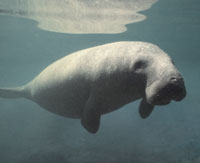 Sea cows: Manatees (family Trichechidae, genus Trichechus) are large aquatic mammals sometimes known as sea cows. The Trichechidae differ from the Dugongidae in the shape of the skull and the shape of the tail. Manatees' tails are paddle-shaped, while the Dugong's are forked. They are herbivores, spending most of their time grazing in shallow waters, and can weigh anywhere from 500 to 1000 kg. When born baby manatees have an average mass of 30 kg. Sea cows: Manatees (family Trichechidae, genus Trichechus) are large aquatic mammals sometimes known as sea cows. The Trichechidae differ from the Dugongidae in the shape of the skull and the shape of the tail. Manatees' tails are paddle-shaped, while the Dugong's are forked. They are herbivores, spending most of their time grazing in shallow waters, and can weigh anywhere from 500 to 1000 kg. When born baby manatees have an average mass of 30 kg.

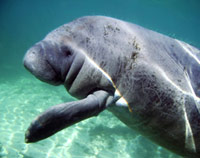 Huge, gentle and curious: Manatees are slow moving, non-aggressive, and generally curious creatures. They enjoy warmer waters and are known to congregate in shallow waters, and frequently migrate through brackish water estuaries to fresh water springs. Their slow moving, curious nature, coupled with dense coastal development, has led to a number of harmful interactions with boat propellers. As a result, a large portion of manatees exhibit propeller scars on their backs. Often the cuts lead to infections which can prove fatal. Internal injuries stemming from hull impacts have also been fatal. Huge, gentle and curious: Manatees are slow moving, non-aggressive, and generally curious creatures. They enjoy warmer waters and are known to congregate in shallow waters, and frequently migrate through brackish water estuaries to fresh water springs. Their slow moving, curious nature, coupled with dense coastal development, has led to a number of harmful interactions with boat propellers. As a result, a large portion of manatees exhibit propeller scars on their backs. Often the cuts lead to infections which can prove fatal. Internal injuries stemming from hull impacts have also been fatal.
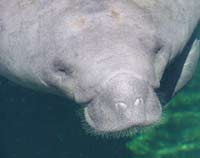 Water sleepers: Manatees inhabit the shallow, marshy coastal areas and rivers of the Caribbean Sea and the Gulf of Mexico (T. manatus, West Indian manatee), the Amazon basin (T. inunguis, Amazonian manatee), and West Africa (T. senegalensis, African manatee). They spend half of their day sleeping in the water, surfacing for air regularly, and at intervals of not longer than 20 minutes. Water sleepers: Manatees inhabit the shallow, marshy coastal areas and rivers of the Caribbean Sea and the Gulf of Mexico (T. manatus, West Indian manatee), the Amazon basin (T. inunguis, Amazonian manatee), and West Africa (T. senegalensis, African manatee). They spend half of their day sleeping in the water, surfacing for air regularly, and at intervals of not longer than 20 minutes.
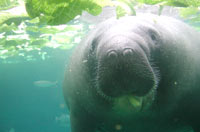 Vegetable munchers: Manatees are herbivores and eat over 60 different plant species such as mangrove leaves, turtle grass, and types of algae, using their divided upper lip. An adult manatee will commonly eat up to 9% of its body weight (approx 50kg) per day. Antillean manatees have been known to eat fish from nets. Vegetable munchers: Manatees are herbivores and eat over 60 different plant species such as mangrove leaves, turtle grass, and types of algae, using their divided upper lip. An adult manatee will commonly eat up to 9% of its body weight (approx 50kg) per day. Antillean manatees have been known to eat fish from nets.
Power plants - the local hangout: Manatees typically inhabit warm, shallow, coastal estuarine waters. Manatees often congregate near power plants, which warm the waters. Some have become reliant on this source of unnatural heat and have ceased migrating to warmer waters. Some power plants have recently been closing and the U.S. Fish and Wildlife Service is trying to find a new way to heat the water for these manatees.

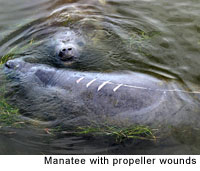 Vulnerable, though not to predators: All three species of manatees are listed by the IUCN as Vulnerable to extinction. Although manatees have no natural predators, manatees occasionally ingest fishing gear (hooks, metal weights, etc.) while feeding. These foreign materials do not seem to harm manatees, except for monofilament line or string. This can get clogged in the animal's digestive system and slowly kill the animal. Manatees can also be crushed in water control structures (navigation locks, flood gates, etc.), drown in pipes and culverts, and are occasionally killed from entanglement in fishing gear, primarily crab pot float lines. Manatees are also vulnerable to red tides, blooms of algae which leach oxygen from the water. And, as stated earlier, there are a huge number of manatees that have had injuries from boat propellers. Vulnerable, though not to predators: All three species of manatees are listed by the IUCN as Vulnerable to extinction. Although manatees have no natural predators, manatees occasionally ingest fishing gear (hooks, metal weights, etc.) while feeding. These foreign materials do not seem to harm manatees, except for monofilament line or string. This can get clogged in the animal's digestive system and slowly kill the animal. Manatees can also be crushed in water control structures (navigation locks, flood gates, etc.), drown in pipes and culverts, and are occasionally killed from entanglement in fishing gear, primarily crab pot float lines. Manatees are also vulnerable to red tides, blooms of algae which leach oxygen from the water. And, as stated earlier, there are a huge number of manatees that have had injuries from boat propellers.
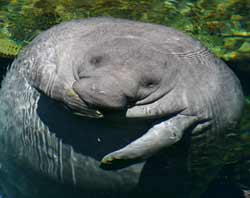 Originally hunted: Manatees were traditionally hunted by indigenous Caribbean people. When Christopher Columbus arrived in the region, manatee hunting was an established trade. Native Americans hunted manatees to make war shields, canoes, and shoes, though the manatee was predominately hunted for its abundant meat. Roman Catholic settlers in the area classified the manatee as a fish, since it lived in water, which made it suitable for Friday meals when eating meat was prohibited. Manatees were also hunted for their valuable bones, which were used to make "Special Potions." Up until the 1800s, museums paid as much as $100 for manatee bones or hides. Though hunting manatees was banned in 1893, illegal poaching of the animals continues to the present day. Originally hunted: Manatees were traditionally hunted by indigenous Caribbean people. When Christopher Columbus arrived in the region, manatee hunting was an established trade. Native Americans hunted manatees to make war shields, canoes, and shoes, though the manatee was predominately hunted for its abundant meat. Roman Catholic settlers in the area classified the manatee as a fish, since it lived in water, which made it suitable for Friday meals when eating meat was prohibited. Manatees were also hunted for their valuable bones, which were used to make "Special Potions." Up until the 1800s, museums paid as much as $100 for manatee bones or hides. Though hunting manatees was banned in 1893, illegal poaching of the animals continues to the present day.
'Endangered' to 'threatened' in Florida: On June 8, 2006, The Florida Fish and Wildlife Conservation Commission voted to reclassify the manatee on Florida's list, to a "threatened" status in that state. While none of the state laws protecting manatees have changed, many wildlife conservationists are not pleased with the removal decision. Manatees remain classified as "endangered" at the federal level.
The population of manatees in Florida is thought to be between 2,000 and 3,000.

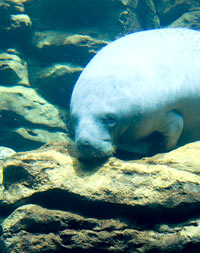 Warm waters: The natural source for warm waters for manatees during the winter is spring fed rivers. The West Indian Manatee migrates into Florida rivers such as the Crystal River, The Homosassa River and The Chassawohitzka River. The head springs of these rivers maintain a water temperature of 72 degrees year round. During the winter months, November to March, approximately 400 West Indian Manatees (According to the National Wildlife Refuge Service) congregate in the rivers in Citrus County, Florida. Warm waters: The natural source for warm waters for manatees during the winter is spring fed rivers. The West Indian Manatee migrates into Florida rivers such as the Crystal River, The Homosassa River and The Chassawohitzka River. The head springs of these rivers maintain a water temperature of 72 degrees year round. During the winter months, November to March, approximately 400 West Indian Manatees (According to the National Wildlife Refuge Service) congregate in the rivers in Citrus County, Florida.
Going North: Manatees have been spotted as far north as Cape Cod, and as recently as the late summer of 2006, one made it up to New York City and Rhode Island's Narragansett Bay, as cited by the Boston Globe. According to Memphis, Tennessee's Commercial Appeal newspaper, one manatee was spotted in the Wolf River harbor near the Mississippi River in downtown Memphis, Tennessee, on October 23, 2006, though it was later found dead ten miles downriver in McKellar Lake.

Mermaids? It is thought that sailors created the myth of the mermaid after mistaking manatees for half-fish, half-human creatures.
The popularity of manatees is steadily growing, as is shown by the appearance of many non-profit organizations which benefit manatees, as well as by references to them in the media.
All text is available under the terms
of the GNU Free Documentation License
|